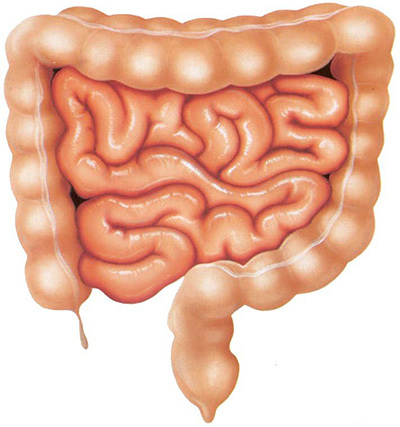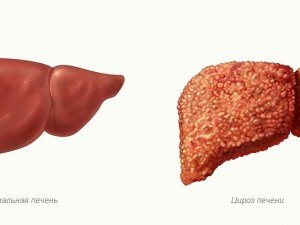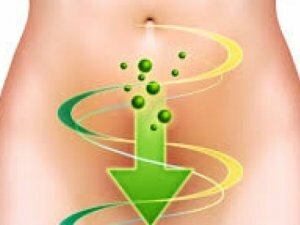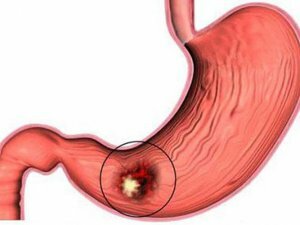The role of the intestine and its microflora
The intestine is the longest section of the digestive tube connecting the mouth and anus. The length of this organ, divided into a small and large intestine, sometimes reaches 6 meters. His role in the harmonious work of our body is extremely important and multifaceted. After all, it is not only( as in a kind of conveyor belt) that food is being eaten, but other serious physiological processes occur in the lumen and in the bowel wall.

Fig.1 - Thick and small intestine of a human.
Bowel functions
In bowel disease or in the removal of individual parts, numerous complaints can appear in patients. And this is not surprising, because the role of a healthy and holistic intestine is to perform many functions. Consider the main ones.
- Transport( motor)
Due to the presence of muscle beams and nerves in the entire intestinal wall, it performs various movements, helping to promote, triturate, compact and mix intestinal contents. Moving through the intestine, under the influence of digestive juices, microbial substances, bile pigments, the contents of the intestine gradually turns into feces, which is consistently transported throughout all parts of the colon( from the blind to the straight).Accumulated feces leave our body through complex coordinated contractions of the rectum.
- Digestive
The ingestion of food from the stomach into the intestine does not stop the digestion process. The small intestine forms about 1.5-2.5 liters of intestinal juice. It contains all the key digestive enzymes: proteases that process protein food structures, amylases that break down sugars, and lipases that affect fats. In addition, pancreatic juice and bile come into the small intestine, the components of which actively digest nutrients. As a result, complex substances for the assimilation of the organism( polymers) are transformed into simple substances( monomers).The large intestine is also capable of producing up to 0.05-0.06 liters of juice with digestive enzymes. They "finish" the work of their small intestine "colleagues."
- Suction
The formed monomers from the intestinal lumen through its wall are absorbed( absorbed) into the blood. Then, together with the blood, they are sent to any structures and organs of the body that need energy and nutrient substances. The small intestine is considered the leader in absorbing activity among all digestive organs. This is facilitated by a special folded structure of its mucosa and the presence of special villi. The localization and intensity of absorption of various substances in the intestine is not the same. If the products of the splitting of proteins, carbohydrates and fats can be absorbed in any part of it, then vitamin B12 and bile salts are absorbed only in the lowest part of the small intestine - the ileum. When it is removed( for example, because of a tumor or constriction), a person is doomed to lifelong injections of vitamin B12.In the colon, the absorption of nutrients continues, but its intensity decreases. In this zone, the absorption of water mainly occurs. In total, the intestine can absorb up to 6-10 liters of contents per day.
- Endocrine ( formation of biologically active substances)
In the intestinal mucosa there are special cells that produce active signaling substances - hormones( gastrin, arthorin, motilin, secretin, etc.).They are able to influence the performance and the motor skills of other digestive( and not only) organs. So, they can not only strengthen or weaken the synthesis of digestive juices, but also regulate appetite, mood and vascular tone.
- Immune
Along with food products, pathogenic viruses, bacteria, toxins, parasites, chemicals and allergens penetrate into the digestive tract. But a healthy intestine is protected by its own protective immune system. Lymphatic tissue is about 25% of its mucosa, forming congestions - Peyer's plaques. In them and in the mucous itself there are active participants in immune reactions - T- and B-lymphocytes. They destroy other people's cells, block allergens, participate in the production of immunoglobulins. The resulting immunoglobulins( especially secretory immunoglobulin A) cover the mucous membrane, forming a special protective film, which prevents the introduction of infectious agents and foreign substances.
- The location of many useful microbes
Finally, the intestine is most densely populated with useful microorganisms: in the small intestine, up to 10 in the 6th degree of bacterial cells in 1 ml are detected, and in the thickest - up to 10 in the 12th degree. Their total number in the large intestine is so great( tens of billions in 1 g of colonic contents), which exceeds the population of our Earth. More than 500 species of tiny microbes live in the lumen of the intestine, and on its walls. They do not cause any disease, but, on the contrary, are faithful helpers of the human body.
Importance of intestinal microflora
In the course of a long evolution between our body and the microflora living in the gut, friendly mutually beneficial relationships have formed. These miniature "tenants" perform many functions that are critically important for a person. These include:
- protective( useful microbes counteract pathogens and viruses, producing harmful substances for them, taking away the products necessary for their life, and forming a barrier that prevents their introduction into the intestinal mucosa);
- the formation of important enzymes for digestion and other active substances( intestinal microflora produces enzymes that can digest sugars and proteins, substances necessary for the exchange of cholesterol, oxalates and bile acid transformations, amino acids);
- production of vitamins( microbial residents of the intestine participate in the formation of vitamins K, B, folic acid, PP);
- is immune( the very presence of microorganisms in the gut constantly trains immunity, besides they stimulate the activity of factors of humoral and cellular immunity and block allergens);
- effect on the absorption of substances necessary to the body( microflora increases the absorption of iron, calcium, vitamins, water in the intestine);
- maintaining a good state of cells of the intestinal mucosa( our microscopic "neighbors" form short-chain fatty acids necessary for the prevention of atrophy and dystrophy of the intestinal mucosa);
- prevention of cancer( due to the isolation of antitumour substances - butirate, golixins, etc., protecting against neoplasms of the intestine and breast);
- neutralization of poisons and toxins( nitrates, toxic derivatives of protein metabolism - scatol, phenol, indole).
Recommended for viewing:



